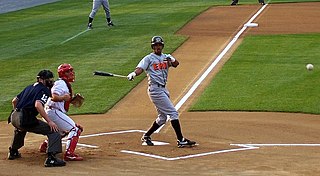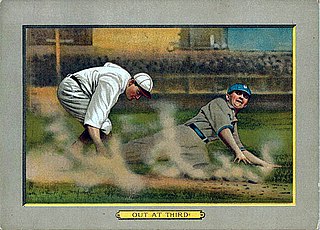
Canadian football, or simply football, is a sport in Canada in which two teams of 12 players each compete on a field 110 yards (101 m) long and 65 yards (59 m) wide, attempting to advance a pointed oval-shaped ball into the opposing team's end zone.

In baseball, the dugout is a team's bench and is located in foul territory between home plate and either first or third base. There are two dugouts, one for the home team and one for the visiting team. In general, the dugout is occupied by all players not prescribed to be on the field at that particular time, as well as coaches and other personnel authorized by the league. The players' equipment is usually stored in the dugout.
Dead ball is a term in many ball sports in which the ball is deemed temporarily not playable, and no movement may be made with it. Depending on the sport, this event may be quite routine, or more uncommon.

In baseball, a foul ball is a batted ball that:

In baseball, an out occurs when the umpire rules a batter or baserunner out. When a batter or runner is out, they lose their ability to score a run and must return to the dugout until their next turn at bat. When three outs are recorded in a half-inning, the batting team's turn expires.

Throughout the history of baseball, the rules have frequently changed as the game continues to evolve. A few common rules most professional leagues have in common is that four balls is a base on balls, three strikes is a strikeout, and three outs end a half-inning.

A baseball field, also called a ball field or baseball diamond, is the field upon which the game of baseball is played. The term can also be used as a metonym for a baseball park. The term sandlot is sometimes used, although this usually refers to less organized venues for activities like sandlot ball.
In baseball, interference occurs in situations in which a person illegally changes the course of play from what is expected. Interference might be committed by players on the offense, players not currently in the game, catchers, umpires, or spectators. Each type of interference is covered differently by the rules.

Pesäpallo is a fast-moving bat-and-ball sport that is often referred to as the national sport of Finland and has some presence in other countries including Germany, Sweden, Switzerland, Australia, and Canada's northern Ontario. It is similar to brännboll, rounders, and lapta, as well as baseball.
In baseball, a catch occurs when a fielder gains secure possession of a batted ball before it bounces, and maintains possession until they voluntarily or intentionally release the ball. When a catch occurs, the batter is out, and runners are in jeopardy of being put out if any fielder with possession of the ball reaches their starting base before they do.

Over-the-line is a bat-and-ball sport, a game related to baseball and softball. Like those games, it involves a batter, pitcher, and fielders. Because a game requires only three people per team, it is considerably easier to get a good informal game going. The equipment consists of a rope, an "official" softball bat & an "official" Orange rubber DeBeer softball. No gloves are allowed while fielding in the Men's divisions unless 60+ years of age. However, gloves are allowed for the women's divisions. Junior events also allow a glove on defense. A single golf glove may be used when batting. Gameplay, however, is very different.

Gameplay in American football consists of a series of downs, individual plays of short duration, outside of which the ball is or is not in play. These can be plays from scrimmage – passes, runs, punts or field goal attempts – or free kicks such as kickoffs and fair catch kicks. Substitutions can be made between downs, which allows for a great deal of specialization as coaches choose the players best suited for each particular situation. During a play, each team should have no more than 11 players on the field, and each of them has specific tasks assigned for that specific play.
In gridiron football, clock management is an aspect of game strategy that focuses on the game clock and/or play clock to achieve a desired result, typically near the end of a match. Depending on the game situation, clock management may entail playing in a manner that either slows or quickens the time elapsed from the game clock, to either extend the match or hasten its end. When the desired outcome is to end the match quicker, it is analogous to "running out the clock" seen in many sports. Clock management strategies are a significant part of American football, where an elaborate set of rules dictates when the game clock stops between downs, and when it continues to run.

Ground rules are rules applying to the field, objects on and near it, and special situations relating to them, in the game of baseball. Major League Baseball has defined a set of "universal ground rules" that apply to all MLB ballparks; individual ballparks have the latitude to set ground rules above and beyond the universal ground rules, as long as they do not directly contradict each other. Additionally, a set of universal ground rules exists for the six MLB stadiums with retractable roofs, with the individual ballparks able to set additional rules.

A comparison of American football and rugby union is possible because of the games' shared origins, despite their dissimilarities.

Bat-and-ball games are field games played by two opposing teams. Action starts when the defending team throws a ball at a dedicated player of the attacking team, who tries to hit it with a bat and run between various safe areas in the field to score runs (points). The defending team can use the ball in various ways against the attacking team's players to force them off the field when they are not in safe zones, and thus prevent them from further scoring. The best known modern bat-and-ball games are cricket and baseball, with common roots in the 18th-century games played in England.
This is an alphabetical list of selected unofficial and specialized terms, phrases, and other jargon used in baseball, along with their definitions, including illustrative examples for many entries.
The following terms are used in American football, both conventional and indoor. Some of these terms are also in use in Canadian football; for a list of terms unique to that code, see Glossary of Canadian football.
Wireball is a street game related to baseball, usually formed as a pick-up game, in urban areas of the United States. The equipment consists of a pimple or pensie pinkie ball and a convenient place in a street or driveway where an electric power line or group of power lines bisect horizontally. The rules come from baseball and are modified to fit the situation. It can be played with one or more persons per team.













